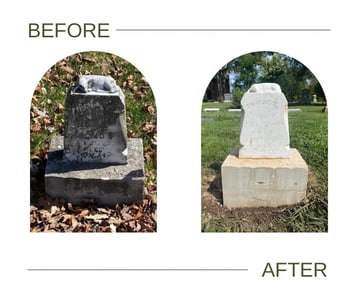Cemeteries are more than a resting place for the departed; they are repositories of history, culture and the stories of generations past.
Through cemetery restoration services like headstone cleaning, realigning rows, fixing broken or chipped monuments, and resetting foundations, it’s possible to preserve and restore the lasting legacy of cemeteries. And while these services may seem straightforward, cemetery restoration isn’t met without misconceptions.
Continue reading as we explore some of the most surprising facts about cemetery restoration projects.
1. Cemetery Restoration Projects Don’t Always Start Immediately
The journey to restoring a cemetery to its former historic beauty is often a lengthy and intricate process that can be filled with long timelines and delays. One of the most common misconceptions about cemetery restoration is that it starts immediately—unfortunately, that’s often not the case. Cemetery restoration projects may not start immediately due to several reasons:
- Funding Constraints: Securing adequate cemetery restoration grants or funding is often a primary hurdle for initiating restoration projects. Organizations or individuals may need time to apply for grants, raise funds through donations or allocate resources from other budgets.
- Seasonal Factors: Depending on the climate and weather conditions, certain times of the year may be more conducive to restoration work. Inclement weather, extreme temperatures or adverse environmental conditions may delay the start of the project until more favorable conditions prevail.
- Logistical Considerations: Restoring cemeteries involves logistical challenges such as coordinating labor, sourcing materials, and arranging for specialized equipment or expertise, which may require careful coordination and preparation before work can begin.
- Assessment and Planning: Before restoration work can commence, a comprehensive assessment of the cemetery's condition and needs is often necessary to determine the scope of the project and develop a restoration plan. This assessment phase may involve surveys, documentation, and consultation with experts, which can take time to complete.
- Planning and Permissions: Restoration efforts may require careful planning, including research, site assessments, and obtaining necessary permissions or permits from local authorities, historical preservation boards, or property owners.
>>> Related Resource: The Cemetery Restoration Process, Step-by-Step
2. Cemetery Restoration Grants Are Available
Depending on the size and service needs, cemetery restoration projects can range from $5,000 to upwards of $250,000. If that’s a price tag that feels unaffordable to your cemetery, you’re not alone—and that’s why cemetery restoration grants exist.
Cemetery restoration grants are financial assistance programs provided by various entities to support the preservation and restoration of historical cemeteries, including activities such as repairing headstones, restoring structures and conducting research. They’re often awarded to municipalities, nonprofit organizations, government entities and more.
Keep in mind that the cemetery grant process can take time. The duration of the grant process for cemetery restoration projects can vary significantly depending on factors such as the specific grant program, the complexity of the project, the availability of funds, and the requirements for application review and approval, but it generally ranges from several months to over a year.
3. Headstones Can Be Restored to Like-New Conditions
It’s not uncommon to visit a cemetery and see headstones that appear dirty, are broken or chipped, or even are unaligned with others. Some may even have illegible lettering, making it difficult to learn about the history and legacy of those laid to rest.

Standard cemetery restoration services aim to solve these issues and can even restore headstones and monuments to like-new conditions. The following are the most common restoration services cemeteries use to return headstones to their original historic beauty:
- Cleaning headstones to remove dirt, biological growth and pollutants.

- Re-engraving lettering and inscriptions that have become illegible due to weathering.
- Re-painting headstones that have faded or diminished from rain, snow and sunlight.
- Fixing broken monuments and memorials to repair structural damage, such as cracks or chips.
- Realigning headstone rows where gravesites may have shifted over time from soil sinking, landscaping or maintenance.

- Re-doing or resetting headstone foundations to provide crucial support, ensuring that the monument remains upright and secure.
Additional restoration services can include digging and re-leveling graves, and relocating monuments and statues.
4. Cemetery Restoration Projects Can Present Preservation Challenges
Cemeteries serve as repositories of cultural heritage, historical significance and collective memory, making preservation of the utmost importance. But due to factors like weathering, natural deterioration, human activities and even neglect, some cemeteries can pose challenging circumstances for preservation and restoration.
Some of the most common cemetery restoration challenges include:
- Weathering and decay due to exposure to the elements, including rain, wind, temperature fluctuations and sunlight. This necessitates preservation efforts focused on cleaning, stabilizing and protecting vulnerable surfaces.


- Fragmentation and displacement of headstones and monuments are common, requiring careful documentation and reconstruction efforts.
- Material degradation of headstone materials—especially for porous materials like marble, sandstone or limestone—further complicates preservation, requiring tailored cleaning, consolidation and repair methods.

- Restoration projects can even uncover historical documentation and interpretation challenges from a lack of comprehensive records, making research and collaboration with historians and genealogists necessary.
Restoration teams may employ specialized techniques and materials to address these challenges while respecting the site's historical integrity.
Request a Quote for Restoration Services
Milano Stone & Restoration has over 50 years of experience in stoneworking and memorial restoration and cleaning. We are one of the few stonework providers in Ohio that offer full cemetery restoration services and have worked with a variety of cemeteries and community parks across the nation to restore their headstones and monuments back to near-original condition. Take the first step to restore your community’s cemetery by contacting our team today.





